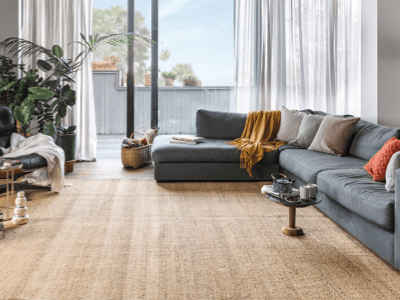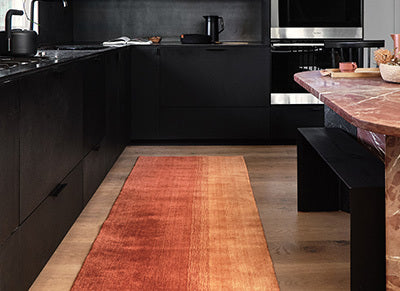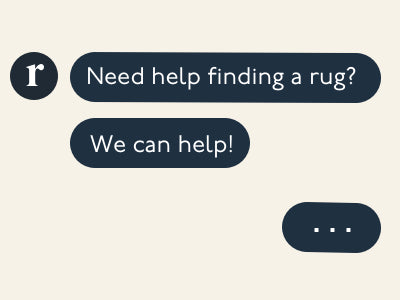














One-of-a-kind new rug, flatwoven by skilled artisans using techniques originated by the Zanafi in the High Atlas mountains of Morocco.
Dimensions: 3'6" x 5'10" (109 cm x 180 cm)
Natural inconsistencies are inherent in these unique, handcrafted rugs
Rug Type:
-
Flatweave Rugs
Reversible rugs without pile, also known as kilims, made by hand-weaving horizontal weft yarns through vertical warp yarns
Age:
-
New
Recently woven and never used in a home
Main Color:
- Purple
- One-of-a-kind new rug — only one in stock!
- 100% wool
- Dimensions: 3'6" x 5'10" (109 cm x 180 cm)
- Fringe: measures 5.9" (15 cm)
- Color palette: lavender, cream
- These rugs are prized for their expressive design and construction. Their freeform edges meander and wiggle, unbound by constrictions of mass production.
- Moroccan rugs don’t come with a key. As with any painting or poem, their motifs have many subjective interpretations. Originally made for personal use, these rugs took months to weave, documenting a shifting tide of events and emotions in the weaver’s life.
- Depending on who you ask, the X symbol stands for the body (wih arms or legs spread out), or scissors, which represent the protective, magical qualities of metal
- A decorative fringe has been hand-tied not just at the top and bottom of the rug, but around all four sides
- A handsome, hand-braided fringe woven from threads of the loom
Zanafi is a term with an obscure origin. It's used to describe a type of chidoui, which is a type of hanbel, or flatweave. It is also a family name in Taznakht. Zanafi rugs display exquisite technical precision, and were designed as floor coverings for guests. These pieces typically fall into two different color palettes: one with a dominance of saffron yellow, the other with undyed black and white wools and a hint of red.
Material DetailsWool, a staple in Moroccan rug design, was considered almost sacred to the Amazigh (Berber) people, whose nomadic lifestyle included sheep and goat herding. In addition to being available, wool is durable, long-lasting, and soft—so it’s super comfy to walk and relax on. In this piece, the wool pile is knotted onto a wool foundation, adding body and helping it hug the floor.
Moroccan wool is locally sourced and produces a thick, strong pile that feels soft and fluffy underfoot. A small amount of shedding is to be expected from this natural fiber, but it’s worth it: its high pile is beloved for its wild, tousled texture.
- Dust and dirt that accumulate in your rug can erode the fibers over time. The best way to combat this is to take your rug outside and give it a good shake once a week. Depending on how large it is, you may need to recruit a friend to help. Also, be sure to get a rug pad—this helps to preserve your rug in spite of dirt.
- If shaking it out isn’t possible, you can vacuum it instead—just be cautious, and don’t use a rotary vacuum, because it can damage the fibers. Once or twice a month, use the suction attachment gently, from side to side. Once or twice a year, flip your rug over and vacuum the back.
- Once a year, let it sunbathe. Hang it in the sun for a few hours when it’s hottest, and flip it over midway through, to expose both sides to direct sunlight. This sun-bleaching helps further sanitize the wool. It’s a natural method to bleach and deodorize it.
- To ensure equal wear and protect against walk patterns, change your rug's direction periodically. You can also flip your rug upside-down once in awhile, and use it like that for a bit. With Moroccan rugs, the back is typically as nice as the front.
- Every 3-5 years, we recommend getting your rug professionally hand-washed with a Moroccan rug expert. Please do not take it to get steam or dry cleaned—this will almost certainly damage the rug! Hand-washing requires the use of a pH-balanced shampoo, worked into the rug by hand with a soft-bristled brush, before being rinsed thoroughly. This process should be repeated a few times.
- In case of spills:
- Blot the spill until it is dry, but do not add liquid. Consult an Oriental rug specialist immediately for cleaning. Adding liquid can make it harder to remove stains, and can even extend them further. This is because moisture travels along the fiber, so in rugs with horizontal fibers (like flatweaves), it can get trapped.
Order A Sample
Harmina - Rug Sample
Size 12" x 12"
Free shipping & return
Recently Viewed
Harmina Moroccan Kilim
Buy One Rug, Get One 50% OFF with code RUGBOGO50—Hurry, BOGO sale ends 12/25! Excludes rug pads and custom rugs.
![]() Free Shipping
Free Shipping
![]() Easy Returns
Easy Returns
One-of-a-kind new rug, flatwoven by skilled artisans using techniques originated by the Zanafi in the High Atlas mountains of Morocco.
Dimensions: 3'6" x 5'10" (109 cm x 180 cm)
Natural inconsistencies are inherent in these unique, handcrafted rugs
- One-of-a-kind new rug — only one in stock!
- 100% wool
- Dimensions: 3'6" x 5'10" (109 cm x 180 cm)
- Fringe: measures 5.9" (15 cm)
- Color palette: lavender, cream
- These rugs are prized for their expressive design and construction. Their freeform edges meander and wiggle, unbound by constrictions of mass production.
- Moroccan rugs don’t come with a key. As with any painting or poem, their motifs have many subjective interpretations. Originally made for personal use, these rugs took months to weave, documenting a shifting tide of events and emotions in the weaver’s life.
- Depending on who you ask, the X symbol stands for the body (wih arms or legs spread out), or scissors, which represent the protective, magical qualities of metal
- A decorative fringe has been hand-tied not just at the top and bottom of the rug, but around all four sides
- A handsome, hand-braided fringe woven from threads of the loom
Zanafi is a term with an obscure origin. It's used to describe a type of chidoui, which is a type of hanbel, or flatweave. It is also a family name in Taznakht. Zanafi rugs display exquisite technical precision, and were designed as floor coverings for guests. These pieces typically fall into two different color palettes: one with a dominance of saffron yellow, the other with undyed black and white wools and a hint of red.
Material DetailsWool, a staple in Moroccan rug design, was considered almost sacred to the Amazigh (Berber) people, whose nomadic lifestyle included sheep and goat herding. In addition to being available, wool is durable, long-lasting, and soft—so it’s super comfy to walk and relax on. In this piece, the wool pile is knotted onto a wool foundation, adding body and helping it hug the floor.
Moroccan wool is locally sourced and produces a thick, strong pile that feels soft and fluffy underfoot. A small amount of shedding is to be expected from this natural fiber, but it’s worth it: its high pile is beloved for its wild, tousled texture.
- Dust and dirt that accumulate in your rug can erode the fibers over time. The best way to combat this is to take your rug outside and give it a good shake once a week. Depending on how large it is, you may need to recruit a friend to help. Also, be sure to get a rug pad—this helps to preserve your rug in spite of dirt.
- If shaking it out isn’t possible, you can vacuum it instead—just be cautious, and don’t use a rotary vacuum, because it can damage the fibers. Once or twice a month, use the suction attachment gently, from side to side. Once or twice a year, flip your rug over and vacuum the back.
- Once a year, let it sunbathe. Hang it in the sun for a few hours when it’s hottest, and flip it over midway through, to expose both sides to direct sunlight. This sun-bleaching helps further sanitize the wool. It’s a natural method to bleach and deodorize it.
- To ensure equal wear and protect against walk patterns, change your rug's direction periodically. You can also flip your rug upside-down once in awhile, and use it like that for a bit. With Moroccan rugs, the back is typically as nice as the front.
- Every 3-5 years, we recommend getting your rug professionally hand-washed with a Moroccan rug expert. Please do not take it to get steam or dry cleaned—this will almost certainly damage the rug! Hand-washing requires the use of a pH-balanced shampoo, worked into the rug by hand with a soft-bristled brush, before being rinsed thoroughly. This process should be repeated a few times.
- In case of spills:
- Blot the spill until it is dry, but do not add liquid. Consult an Oriental rug specialist immediately for cleaning. Adding liquid can make it harder to remove stains, and can even extend them further. This is because moisture travels along the fiber, so in rugs with horizontal fibers (like flatweaves), it can get trapped.






